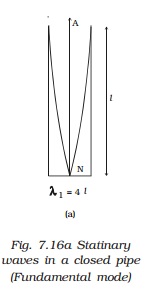Chapter: 11th 12th std standard Class Physics sciense Higher secondary school College Notes
Vibrations of air column in Organ pipes

Vibrations of air
column in pipes
Musical wind
instruments like flute, clarinet etc. are based on the principle of vibrations
of air columns. Due to the superposition of the incident wave and the reflected
wave, longitudinal stationary waves are formed in the pipe.
1.Organ pipes
Organ
pipes are musical instruments which are used to produce musical sound by
blowing air into the pipe. Organ pipes are two types
(i) closed organ pipes, closed at one end
(ii) open organ pipe, open
at both ends.
Closed organ pipe : If the air is blown lightly at the open end of
the closed organ pipe, then the air column vibrates (Fig. a) in the fundamental
mode. There is a node at the closed end and an antinode at the open end. If l is the length of the tube.

l = λ1/4
or
λ1
= 4l
If
n1 is the fundamental frequency of the vibrations and v is the
velocity of sound in air, then
n1
= v / λ1 = v/4l
If
air is blown strongly at the open end, frequencies higher than fundamental
frequency can be produced. They are called overtones. Fig. b & Fig. c shows
the mode of vibration with two or more nodes and antinodes.
l=3
λ3/4 or λ3=4l/3
n3
= v/ λ3=3v/4l=3n1
This
is the first overtone or third harmonic.
Similarly
n5 =5v/4l=5n1
This
is called as second overtone or fifth harmonic.
Therefore
the frequency of pth overtone is (2p + 1) n1 where n1 is the
fundamental frequency. In a closed pipe only odd harmonics are produced. The
frequencies of harmonics are in the ratio of 1 : 3 : 5.....

(ii) Open organ pipe -
When air is blown into the open organ pipe, the air column vibrates in the
fundamental mode Fig. a. Antinodes are formed at the ends and a node is formed
in the middle of the pipe. If l is the length of the pipe, then
l=
λ1/2
or
λ1=2l
v=n1
λ1= n1 2 l
The
fundamental frequency
n1=v/2 l

In
the next mode of vibration additional nodes and antinodes are formed as shown
in Fig. b and Fig. c.
l = λ2
or v = n2λ2 = n2 . l
∴ n2 =(v/l)=2n1
This
is the first overtone or second harmonic.
Similarly,
n3 =v/ λ3=3v/2l=3n1
This
is the second overtone or third
harmonic.
Therefore
the frequency of Pth overtone is (P + 1) n1 where n1 is
the fundamental frequency.
The
frequencies of harmonics are in the ratio of 1 : 2 : 3 ....

Related Topics